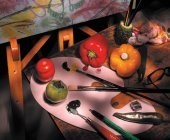|
ApertureAperture or iris in a camera lens controls the amount of light passing through the lens. It is constructed with a set of blades, over-lapping each other and it can be adjusted for more or less opening.
As we know, shutter controls the duration and time of exposure, opening of iris controls the amount of light reaching the film or digital image sensor. This product of shutter and iris should be constant for given exposure (for constant ISO value), means that more the time we allow for the shutter to remain open, smaller the opening of the iris, and if we reduce the shutter time, we will have to compensate with wider opening.
Aperture setting is a number on lens barrel. These numbers are 1, 1.4, 2, 2.8, 4, 5.6, 8, 11, 16, 22, 32, 45, 64, 90 and so on.They are termed as f-number. These settings are at full value. It looks little complicated but if you notice, each alternate number is double in mathematical value. Higher the value, less the diameter and smaller the size of opening. Mechanical setting can be set at half value or in some lenses, it can be set at any in between value. Digital camera shows number on display screen, so these numbers are added with numerical value for in between settings. Thus a digital display shows f25 for one third stop more than f22 and f29 for two third stop more value. Flash light exposure meters are designed to display value at 1/10. So in this case, the flash light exposure meter may show value at 5.6.9 - which is actually very close to f8 (only 1/10 stop more)
This number is derived by the following formula: Focal length of a lens in mm / effective lens opening diameter in mm = f-number Example: If focal length of the lens is 50 mm and opening of the lens is 25 mm then, 50 / 25 = 2 So the f-no is 2
Effect of lens opening is on exposure. Each next value cuts the amount of light by half. That means if we set the opening at f5.6, to allow certain amount of light to pass, it will cut the amount to half if we set it at f8. It will allow double the amount of light to pass if we set it at f4. This amount of light passing through lens, should be constant for given lighting condition and given ISO value. So if we change the opening, we have to compensate it with shutter speed.
When the camera is set on an aperture priority mode, we can select the aperture we want to use and the camera will set the shutter speed automatically.
Wider opening will give us shallow depth of field. Narrower opening, (higher f no.) will increase depth of field. (read more about depth of field in detail) Read more about:
Auto focus mechanism of camera
Other photographic accessories
Read about how to set a lens for hyper-focal distance |






